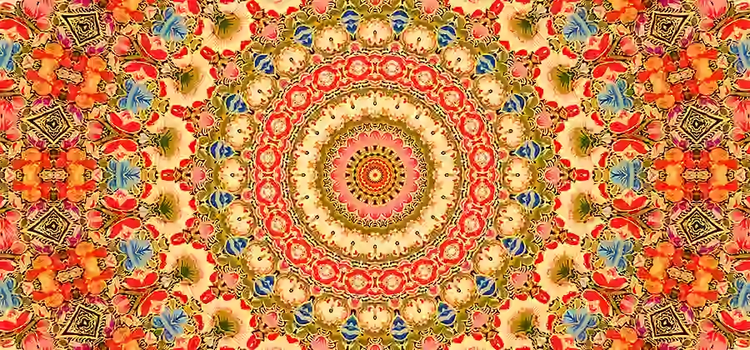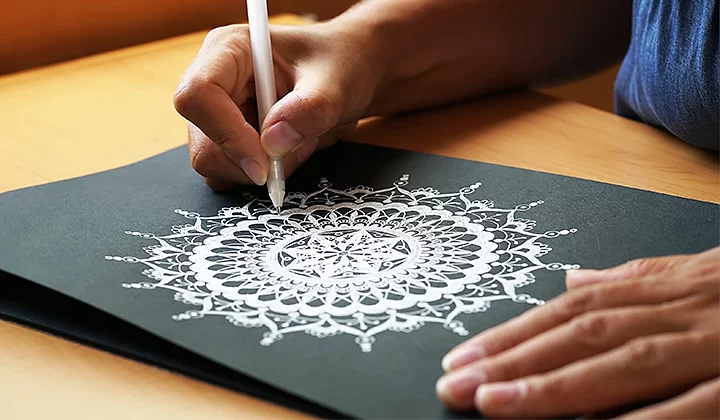DISEÑO
Crea belleza y encuentra tu paz interior con el arte mandala
Descubre la historia del diseño mandala y obtén consejos sobre cómo dibujar estos símbolos sagrados.

¿Qué es un mandala?
En sánscrito, la antigua lengua del budismo y el hinduismo, la palabra mandala significa “círculo”. Según la tradición, un mandala es un diseño o patrón geométrico que representa el cosmos o a las deidades en diversos mundos celestiales. “Todo se reduce a encontrar la paz en la simetría del diseño y del universo”, cuenta la artista Saudamini Madra.
La artista y profesora de matemáticas Fernanda Bonafini comenzó a hacer mandalas por puro placer. “Cuando dibujo la ilustración de un mandala, me siento mucho más tranquila y serena, y mi respiración y pulso cardíaco se ralentizan. La sensación en tu mente y cuerpo, y de cómo ambos se conectan, es maravillosa”, declara Bonafini.
Personas de distintas culturas de todo el mundo han creado mandalas, lo que sugiere que sus formas conectan con el interior de todo ser humano. El brillante psicoanalista Carl Jung sostenía que el mandala representa el Yo y que, por tanto, dibujar un mandala proporciona un lugar sagrado en el que podemos conocer quiénes somos. Consideraba que hacer mandalas es una terapia artística eficaz que ayuda a tranquilizar y consolar a las personas con problemas de salud mental.
Tanto la cultura maya como la azteca, la aborigen australiana y la católica europea han creado mandalas de una forma u otra, aunque es una manifestación más habitual del arte hindú y budista del subcontinente indio.

Mandalas budistas con arena
Durante siglos, los monjes budistas tibetanos han creado estos diagramas cósmicos con arena de colores. A medida que disponen cada grano de arena a consciencia con palos y embudos de metal, los monjes entran en un estado mental que les permite fluir. Cuando llegan al punto central de su composición, experimentan la trascendencia del Yo y alcanzan la realidad de un universo en la que todos los seres se han liberado de su sufrimiento. Entonces, después de días o incluso semanas de trabajo, practican el desapego y demuestran la impermanencia de las cosas destruyendo su mandala.

Mandalas hindús
Los mandalas hindús, también llamados yantras, provienen del budismo. Los yantras tradicionales son cuadrados, con una puerta a cada lado alrededor de un círculo central que contiene uno de los dioses hindús. Mediante la creación meditativa del mandala, su artista invoca al Dios para obtener ayuda en la búsqueda de verdades cósmicas.

Cómo crear tu propio mandala
Empieza con una idea general de lo que quieres crear. Decide si va a ser circular o rectangular, blanco, negro o a color. Si te gustan los mandalas florales, puedes dibujar pétalos y hojas, aunque no te preocupes si no tienes claro lo que quieres. “Algunas veces, no tengo ni idea de lo que estoy haciendo”, reconoce Madra. “Simplemente, empiezo por la capa más pequeña, el círculo más interno, y lo hago crecer y va cambiando. Me gusta que fluya con libertad”. Si necesitas inspiración, estudia posibles patrones de tu entorno o mira en Behance algunos de los mandalas de ejemplo.
El primer paso para hacer un mandala es crear una cuadrícula. “Lo suyo es que sea simétrico y que todos los patrones sean iguales”, explica Madra. Bonafini recomienda dibujar las líneas de la cuadrícula de forma que atraviesen el círculo cada 30 o 45 grados. Independientemente de que la forma general de tu mandala sea cuadrada o circular, puedes comenzar en torno al punto central con un círculo. Después, podrás decidir qué formas básicas te gustaría que salieran de ese círculo, como una V o U invertidas. Entonces, la próxima capa debería ser ligeramente distinta. Puede que cambies la forma un poco, o que la rellenes con distintos trazos o colores. “El patrón es el mismo, pero estas pequeñas variaciones aportarán un aspecto diferente una vez terminada la obra”, comenta Madra.
Si no tienes claro qué patrón aplicar, estudia los de otros mandalas que te gusten. Elige patrones con los que puedas identificarte y combínalos a tu gusto. Bonafini recomienda poner en práctica los patrones por separado antes de colocarlos en un círculo. “Entrena el movimiento con el brazo para que todos tengan el mismo tamaño. Eso es lo que le da un aspecto estéticamente agradable”.
Madra propone recopilar todos los patrones que te gusten. “Crea un repositorio de patrones para que, cada vez que te bloquees o sientas que dibujas los mismos diseños una y otra vez, puedas recurrir a él”.

La ventaja del dibujo digital
No tienes que dibujar en la arena ni con bolígrafos de tinta de gel para crear un precioso mandala. A Bonafini le encanta dibujar en su tableta. “Creo algo y, si no me gusta, lo borro. Puedo hacer el mismo patrón varias veces. En papel, si imagino algo que luego no funciona, pierdo todo lo que he hecho”. Además, una tableta te permite llevar todo tu material artístico allá adonde vayas. Podrás continuar con tu mandala cuando te llegue la inspiración.

Ahorra tiempo con la simetría
Crea mandalas espectaculares en un momento con las opciones de simetría de Adobe Photoshop. Puedes conseguir una simetría instantánea haciendo clic en el ícono de la mariposa, en la barra de opciones, para abrir el menú y pintar con simetría.
Elige entre la simetría Radial o Mandala para dividir tus círculos en segmentos. El modo radial te permite escoger hasta 12 segmentos y cada trazo de pincel se reproduce alrededor del punto central. Con el modo mandala, puedes seleccionar hasta 10 segmentos a la vez. Las marcas que hagas en el lienzo se reflejarán a modo de espejo y se reproducirán en cada segmento. Es fácil e hipnótico, te sorprenden los bonitos diseños que puedes crear tan rápidamente.
En una capa nueva, selecciona las herramientas Pincel, Lápiz o Borrador. Recuerda que puedes variar los trazos del pincel y utilizar técnicas de acuarela. Si pones cada anillo en una capa separada, puedes cambiar sus líneas o su sombreado sin tener que modificar todos los demás anillos.
A medida que ganes experiencia e incorpores más complejidad a tus patrones, ten en cuenta el consejo de Madra para principiantes: “Recuerda siempre la regla de las tres P: práctica, paciencia y perseverancia”.
